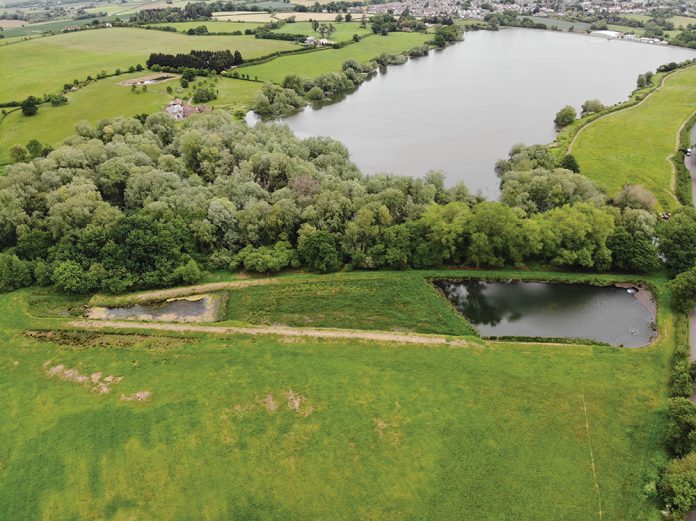New wetlands next to Somerset’s Durleigh Reservoir are delivering significant biodiversity and water quality improvements, as Wessex Water continues its industry-leading drive to find nature-based solutions to some of our biggest environmental challenges.
The two new habitats, constructed to the west of the water treatment centre and reservoir near Bridgwater, have brought about a near-75 per cent reduction in the amount of ammonia present in water, while phosphorus and sediments have dropped by around a third.
Reverting cultivated land to a natural state, restoring the river to its former location and reconnecting it to its floodplain has seen biodiversity increase by between 55 and 76 per cent, according to measurements calculated through the Natural England Biodiversity Metric.
This is set to increase as the habitats mature, with Wessex Water regularly sampling and analysing the wetlands that were constructed as part of a three-year £50 million refurbishment of the Durleigh Water Treatment Centre, which returned to operation last year.
Based at the head of the reservoir, the wetlands have been designed to filter silt and coarse sediment and reduce levels of nutrients, helping to improve the raw water quality entering the reservoir as well as boosting biodiversity by becoming home to a diverse array of wildlife. An existing wet woodland also acts as a final screening process before the water reaches the reservoir.
Durleigh’s now-rebuilt water recycling centre had previously suffered with poor raw water quality, deteriorating over decades, with the wetlands supporting the revamped treatment processes to ensure the site could continue to deliver the highest quality drinking water to thousands of customers in the region.
Wessex Water’s Biodiversity and Wetlands project manager Sarah Williams said: “As well as enhancing wildlife and biodiversity these wetlands are a great example of how we can harness the power of nature to support our water supply operation.
“Each wetland at Durleigh has its own purpose – a naturalised wetland captures sediment and silt by connecting the Durleigh Brook back to its floodplain while a constructed wetland area improves the quality of supply from the Bridgwater and Taunton Canal, as well as recycled water from the water treatment centre itself.
“The wetlands also support the work of our catchment delivery team with local farmers to reduce pesticides and silt entering the Durleigh Brook that flows down to the reservoir.
“This area is one of our most biodiverse and is becoming home to lots of aquatic-loving species and the newly-created habitats have brought significant wildlife benefits, being home to amphibians, dragonflies, birds and wildflowers.
“It’s also home to our first staff forest where we plant trees every year. As well as the wildlife, the constructed wetlands are removing nutrients, mainly ammonia and phosphorus before the water enters the reservoir.’’
Durleigh is one of a number of wetlands projects already completed or in planning by Wessex Water at both water recycling and water treatment centres throughout the region, as the company actively sources more natural solutions to tackling key environmental issues.
A constructed wetland downstream from the Cromhall Water Recycling Centre in south Gloucestershire is continuing to provide pioneering results for the water industry, having been designed to remove phosphorus from the treatment process.
Findings released last year revealed that such a wetland could keep the concentration of phosphates in effluent within permitted limits and effectively remove microplastics and more than 70 per cent of some compounds from the water, as well as reducing the bacteria being released into the environment by more than 95 per cent.
In addition, wetlands or reedbeds are among 28 natural solutions being developed throughout the Wessex Water region before 2025 to help reduce the instances of storm overflows operating, by completing the treatment process for excess groundwater entering the sewerage system and combining with foul water.
Similarly, the company’s Catchment Delivery Team is working with farmers and landowners in the Dorset Stour and Somerset to identify opportunities for nature-based solutions to further offset phosphorus from water recycling centres or developments, whilst providing biodiversity and carbon benefits.
Wessex Water’s Director of Environmental Solutions Ruth Barden added: “Wessex Water is leading the way in applying nature-based solutions, such as wetlands and testing their effectiveness in tackling the environmental challenges that we all face.
“We are continuing to monitor the effectiveness of sites like Durleigh, examining chemical and biological data to inform our future investment decisions.
“This will help us pursue a more sustainable approach towards improving water quality and local biodiversity of our water courses as well as delivering lower carbon and more cost-effective solutions for water supply, sewage works discharges and storm overflows.’’



